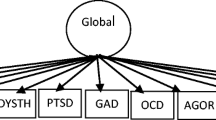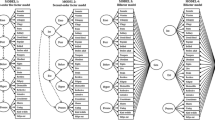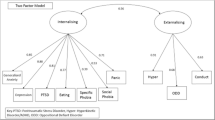Abstract
Confirmatory factor analyses were conducted of Diagnostic and Statistical Manual of Mental Disorders, Fourth Edition (DSM-IV) symptoms of common mental disorders derived from structured interviews of a representative sample of 4,049 twin children and adolescents and their adult caretakers. A dimensional model based on the assignment of symptoms to syndromes in DSM-IV fit better than alternative models, but some dimensions were highly correlated. Modest sex and age differences in factor loadings and correlations were found that suggest that the dimensions of psychopathology are stable across sex and age, but slightly more differentiated at older ages and in males. The dimensions of symptoms were found to be hierarchically organized within higher-order “externalizing” and “internalizing” dimensions, which accounted for much of their variance. Major depression and generalized anxiety disorder were substantially correlated with both the “externalizing” dimension and the “internalizing” dimension, however, suggesting the need to reconceptualize the nature of these higher-order dimensions.







Similar content being viewed by others
References
Achenbach, T. M. (1978). The child behavior profile: I. Boys aged 6–11. Journal of Consulting and Clinical Psychology, 46, 478–488.
Achenbach, T. M. (1991). Manual for the Child Behavior Checklist/4–18 and 1991 profile. Burlington: University of Vermont Department of Psychiatry.
Achenbach, T. M., McConaughy, S. H., & Howell, C. T. (1987) Child/adolescent behavioral and emotional problems: Implications of cross-informant correlations for situational specificity. Psychological Bulletin, 101, 213–232.
American Association for Public Opinion Research (2000). Standard definitions: Final dispositions of case codes and outcome rates for surveys. Ann Arbor: American Association for Public Opinion Research.
American Psychiatric Association (1994). Diagnostic and statistical manual of mental disorders (4th ed.). Washington, DC: American Psychiatric Association.
Angold, A., Costello, E. J., & Erkanli, A. (1999). Comorbidity. Journal of Child Psychology and Psychiatry, 40, 57–87.
Beiser, M., Dion, R., & Gotowiec, A. (2000). Structure of attention-deficit and hyperactivity symptoms among native and non-native elementary school children. Journal of Abnormal Child Psychology, 28, 425–437.
Bird, H. R., Gould, M. S., & Staghezza, B. (1992). Aggregating data from multiple informants in child psychiatry epidemiological research. Journal of the American Academy of Child and Adolescent Psychiatry, 31, 78–85.
Boyle, M. H., Offord, D. R., Racine, Y., Szatmari, P., Fleming, J. E., & Sanford, M. (1996). Identifying thresholds for classifying childhood psychiatric disorder: Issues and prospects. Journal of the American Academy of Child and Adolescent Psychiatry, 35, 1440–1448.
Burke, J. D., Loeber, R., & Lahey, B. B. (2005). Developmental transitions among affective and behavioural disorders in adolescent boys. Journal of Child Psychology and Psychiatry, 46, 1200–1210.
Burns, G. L., Boe, B., Walsh, J. A., Sommers-Flannagan, R., & Teegarden, L. A. (2001). A confirmatory factor analysis on the DSM-IV ADHD and ODD symptoms: What is the best model for the organization of these symptoms? Journal of Abnormal Child Psychology, 29, 339–349.
Burns, G. L., Walsh, J. A., Patterson, D. R., Holte, C. S., Sommers-Flannagan, R., & Parker, C. M. (1997). Internal validity of disruptive behavior disorder symptoms: Implications from parent ratings for a dimensional approach to symptom validity. Journal of Abnormal Child Psychology, 25, 307–319.
Capaldi, D. M. (1991). Co-occurrence of conduct problems and depressive symptoms in early adolescent boys: I. Familial factors and general adjustment at grade 6. Development and Psychopathology, 4, 125–144.
Chorpita, B. F., Yim, L., Moffitt, C., Umemoto, L. A., & Francis, S. E. (2000). Assessment of symptoms of DSM-IV anxiety and depression in children: A revised child anxiety and depression scale. Behaviour Research and Therapy, 38, 835–855.
Costello, E. J., Egger, H. L., & Angold, A. (2005). The developmental epidemiology of anxiety disorders: Phenomenology, prevalence, and comorbidity. Child and Adolescent Psychiatric Clinics of North America, 14, 631–648.
de Ross, R., Gullone, E., & Chorpita, B. F. (2002). The revised child anxiety and depression scale: A psychometric investigation with Australian youth. Behaviour Change, 19, 90–101.
DuPaul, G. J., Anastopoulos, A. D., Power, T. J., Reid, R., Ikeda, M. J., & McGoey, K. E. (1998). Parent ratings of attention-deficit/hyperactivity disorder symptoms: Factor structure and normative data. Journal of Psychopathology and Behavioral Assessment, 20, 83–102.
Edelbrock, C., Costello, A., Dulcan, M., Kalas, R., & Conover, N. (1985). Age differences in the reliability of the psychiatric interview of the child. Child Development, 56, 265–275.
Ehringer, M. A., Rhee, S. H., Young, S., Corley, R., & Hewitt, J. K. (2006). Genetic and environmental contributions to common psychopathologies of childhood and adolescence: A study of twins and their siblings. Journal of Abnormal Child Psychology, 34, 1–17.
Fergusson, D. M., Lynskey, M. T., & Horwood, L. J. (1996). Origins of comorbidity between conduct and affective disorders. Journal of the American Academy of Child & Adolescent Psychiatry, 35, 451–460.
Frick, P. J., Lahey, B. B., Applegate, B., Kerdyck, L., Ollendick, T., Hynd, G. W., et al. (1994). DSM-IV field trials for the disruptive behavior disorders: Symptom utility estimates. Journal of the American Academy of Child and Adolescent Psychiatry, 33, 529–539.
Gomez, R., Burns, G. L., Walsh, J. A., & Hafetz, N. (2005). A multitrait–multisource confirmatory factor analytic approach to the construct validity of ADHD and ODD rating scales with Malaysian children. Journal of Abnormal Child Psychology, 33, 241–254.
Hankin, B. L., Fraley, R. C., Lahey, B. B., & Waldman, I. D. (2005). Is depression best viewed as a continuum or a discrete category? A taxometric analysis of child and adolescent depression in a population-based sample. Journal of Abnormal Psychology, 114, 96–110.
Hart, E. L., Lahey, B. B., Loeber, R., & Hanson, K. S. (1994). Criterion validity of informants in the diagnosis of disruptive behavior disorders in children: A preliminary study. Journal of Consulting and Clinical Psychology, 62, 410–414.
Hartman, C., Hox, J., Mellenbergh, G. J., Boyle, M. H., Offord, D. R., Racine, Y., et al. (2001). DSM-IV internal construct validity: When a taxonomy meets data. Journal of Child Psychology and Psychiatry, 42, 817–836.
Haslam, N., Williams, B., Prior, M., Haslam, R., Graetz, B., & Sawyer, M. (2006). The latent structure of attention-deficit/hyperactivity disorder: A taxometric analysis. Australian and New Zealand Journal of Psychiatry, 40, 639–647.
Hicks, B. M., Krueger, R. F., Iacono, W. G., McGue, M., & Patrick, C. J. (2004). Family transmission and heritability of externalizing disorders: A twin-family study. Archives of General Psychiatry, 61, 922–928.
Jensem, G. J., & Eve, R. (1976). Sex differences in delinquency: An examination of popular sociological explanations. Criminology, 13, 427–448.
Jensen, P. S., Rubio-Stipec, M., Canino, G., Bird, H. R., Dulcan, M. K., Schwab-Stone, M. E., et al. (1999). Parent and child contributions to diagnosis of mental disorder: Are both informants always necessary? Journal of the American Academy of Child and Adolescent Psychiatry, 38, 1569–1579.
Kendler, K. S., Neale, M. C., Kessler, R. C., Heath, A. C., & Eaves, L. (1992). Major depression and generalized anxiety disorder: Same genes, (partly) different environments? Archives of General Psychiatry, 49, 716–722.
Kendler, K. S., Prescott, C. A., Myers, J., & Neale, M. C. (2003). The structure of genetic and environmental risk factors for common psychiatric and substance use disorders in men and women. Archives of General Psychiatry, 60, 929–937.
Kessler, R. C., Stang, P., Wittchen, H.-U., Stein, M., & Walters, E. E. (1999). Lifetime co-morbidities between social phobia and mood disorders in the U. S. National Comorbidity Survey. Psychological Medicine, 29, 555–567.
Krueger, R. F. (1999). The structure of common mental disorders. Archives of General Psychiatry, 56, 921–926.
Krueger, R. F., Markon, K. E., Patrick, C. J., & Iacono, W. G. (2005). Externalizing psychopathology in adulthood: A dimensional-spectrum conceptualization and its implications for DSM-V. Journal of Abnormal Psychology, 114, 537–550.
Lahey, B. B., Applegate, B., Barkley, R. A., Garfinkel, B., McBurnett, K., Kerdyk, L., et al. (1994a). DSM-IV field trials for oppositional defiant disorder and conduct disorder in children and adolescents. American Journal of Psychiatry, 151, 1163–1171.
Lahey, B. B., Applegate, B., McBurnett, K., Biederman, J., Greenhill, L., Hynd, G. W., et al. (1994b). DSM-IV field trials for attention deficit/hyperactivity disorder in children and adolescents. American Journal of Psychiatry, 151, 1673–1685.
Lahey, B. B., Applegate, B., Waldman, I. D., Loft, J. D., Hankin, B. L., & Rick, J. (2004). The structure of child and adolescent psychopathology: Generating new hypotheses. Journal of Abnormal Psychology, 113, 358–385.
Lahey, B. B., Loeber, R., Burke, J. D., Rathouz, P., & McBurnett, K. (2002). Waxing and waning in concert: Dynamic comorbidity of conduct disorder with other disruptive and emotional problems over seven years among clinic-referred boys. Journal of Abnormal Psychology, 111, 556–567.
Lahey, B. B., Miller, T. L., Gordon, R. A., & Riley, A. (1999). Developmental epidemiology of the disruptive behavior disorders. In H. Quay & A. Hogan (Eds.), Handbook of the disruptive behavior disorders (pp. 23–48). New York: Plenum.
Loeber, R., Green, S. M., Lahey, B. B., & Stouthamer-Loeber, M. (1989). Optimal informants on childhood disruptive behaviors. Development and Psychopathology, 1, 317–337.
Magee, W. J., Eaton, W. W., Wittchen, H.-U., McGonagle, K. A., & Kessler, R. C. (1996). Agoraphobia, simple phobia, and social phobia in the National Comorbidity Survey. Archives of General Psychiatry, 53, 159–168.
Markon, K. E., & Krueger, R. F. (2004). An empirical comparison of information—theoretic selection criteria for multivariate behavior genetic models. Behavior Genetics, 34, 593–610.
Marsh, H. W., & Hocevar, D. (1985). Application of confirmatory factor analysis to the study of self-concept: First- and higher-order factor models and their invariance across groups. Psychological Bulletin, 97, 562–582.
Merikangas, K. R., & Angst, J. (1995). Comorbidity and social phobia: Evidence from clinical, epidemiologic, and genetic studies. European Archives of Psychiatry and Clinical Neuroscience, 244, 297–303.
Mineka, S., Watson, D., & Clark, L. A. (1998). Comorbidity of anxiety and unipolar mood disorders. Annual Review of Psychology, 49, 377–412.
Moffitt, T. E., Caspi, A., Harrington, H., Milne, B. J., Melchior, M., Goldberg, D., et al. (2007). Generalized anxiety disorder and depression: Childhood risk factors in a birth cohort followed to age 32. Psychological Medicine, 37, 441–452.
Muris, P., & Meesters, C. (2003). The validity of attention deficit hyperactivity and hyperkinetic disorder symptom domains in nonclinical Dutch children. Journal of Clinical Child and Adolescent Psychology, 32, 460–466.
Muthén, B. O. (2004). Mplus technical appendices. Los Angeles: Muthén & Muthén.
Nauta, M. H., Scholing, A., Rapee, R. M., Abbott, M., Spence, S. H., & Waters, A. (2004). A parent-report measure of children’s anxiety: Psychometric properties and comparison with child-report in a clinic and normal sample. Behaviour Research and Therapy, 42, 813–839.
Nottelmann, E. D., & Jensen, P. S. (1995). Comorbidity of disorders in children and adolescents: Developmental perspectives. In T. H. Ollendick & R. J. Prinz (Eds.), Advances in clinical child psychology, volume 17 (pp 109–155). New York: Plenum.
Rowe, R., Maughan, B., Costello, E. J., & Angold, A. (2005). Defining oppositional defiant disorder. Journal of Child Psychology and Psychiatry, 46, 1309–1316.
Rutter, M. (1997). Comorbidity: Concepts, claims and choices. Criminal Behaviour and Mental Health, 7, 265–285.
Rutter, M., & Redshaw, J. (1991). Growing up as a twin: Twin–singleton differences in psychological development. Journal of Child Psychology and Psychiatry, 32, 885–895.
Satorra, A., & Bentler, P. M. (2001). A scaled difference chi-square test statistic for moment structure analysis. Psychometrika, 66, 507–514.
Schwab-Stone, M., Fallon, T., Briggs, M., & Crowther, B. (1994). Reliability of diagnostic reporting for children aged 6–11 years: A test–retest study of the Diagnostic Interview Schedule for Children—Revised. American Journal of Psychiatry, 151, 1048–1054.
Shaffer, D., Fisher, P., Dulcan, M., Davies, M., Piacentini, J., Schwab-Stone, M., et al. (1996). The NIMH diagnostic interview schedule for children (DISC 2.3): Description, acceptability, prevalences, and performance in the MECA study. Journal of the American Academy of Child and Adolescent Psychiatry, 35, 865–877.
Spence, S. H. (1997). Structure of anxiety symptoms among children: A confirmatory factor-analytic study. Journal of Abnormal Psychology, 106, 280–297.
Vollebergh, W. A. M., Iedema, J., Bijl, R. V., de Graaf, R., Smit, F., & Ormel, J. (2001). The structure and stability of common mental disorders: The NEMESIS Study. Archives of General Psychiatry, 58, 597–603.
Waldman, I. D., Lilienfeld, S. O., & Lahey, B. B. (1995). Toward construct validity in the childhood disruptive behavior disorders: Classification and diagnosis in DSM-IV and beyond. In T. H. Ollendick & R. J. Prinz (Eds.), Advances in clinical child psychology. Volume 17 (pp. 323–364). New York: Plenum.
Watson, D. (2005). Rethinking the mood and anxiety disorders: A quantitative hierarchical model for DSM-V. Journal of Abnormal Psychology, 114, 522–536.
World Health Organization (1993). The ICD-10 classification of mental and behavioural disorders: Diagnostic criteria for research, 10th edition. Geneva: World Health Organization.
Acknowledgements
This study was supported by NIMH grants R01 MH59111 to Benjamin B. Lahey and K01-MH01818 to Irwin D. Waldman. We greatly appreciate the helpful advice given to us by Catharina Hartman and Bengt Muthén regarding the CFA.
Author information
Authors and Affiliations
Corresponding author
Rights and permissions
About this article
Cite this article
Lahey, B.B., Rathouz, P.J., Van Hulle, C. et al. Testing Structural Models of DSM-IV Symptoms of Common Forms of Child and Adolescent Psychopathology. J Abnorm Child Psychol 36, 187–206 (2008). https://doi.org/10.1007/s10802-007-9169-5
Received:
Accepted:
Published:
Issue Date:
DOI: https://doi.org/10.1007/s10802-007-9169-5




